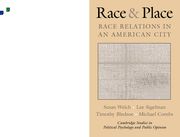Book contents
- Frontmatter
- Contents
- List of Figures
- List of Tables
- Preface
- 1 Introduction
- 2 Race Relations in Detroit, 1968–1992
- 3 Black–White Social Interaction
- 4 Perceptions of Racial Discrimination
- 5 Black Racial Solidarity
- 6 White Racial Prejudice
- 7 Opinions on Urban Issues: The Schools and the Police
- 8 Conclusions
- Appendix A The Detroit Surveys
- Appendix B Detroit Survey Items and Measures
- References
- Author Index
- Subject Index
- Miscellaneous Endmatter
6 - White Racial Prejudice
Published online by Cambridge University Press: 05 June 2012
- Frontmatter
- Contents
- List of Figures
- List of Tables
- Preface
- 1 Introduction
- 2 Race Relations in Detroit, 1968–1992
- 3 Black–White Social Interaction
- 4 Perceptions of Racial Discrimination
- 5 Black Racial Solidarity
- 6 White Racial Prejudice
- 7 Opinions on Urban Issues: The Schools and the Police
- 8 Conclusions
- Appendix A The Detroit Surveys
- Appendix B Detroit Survey Items and Measures
- References
- Author Index
- Subject Index
- Miscellaneous Endmatter
Summary
“I was shocked by the vulgarity of their speech, their loudness and their inappropriate behavior. … I … came to resent them because their behavior wouldn't have been tolerated had they been anything but black… Now I consider myself a racist” (Baillie, 2000). Relatively few whites would admit to the kind of racial prejudice that would lead them to judge an African American as inferior biologically. Like the white woman whose description of her co-workers is quoted above, though, many more do not hesitate to label black Americans as less hard working, less well behaved, less motivated, or falling short in other ways as compared with whites.
Of course, the degree of racial prejudice varies widely among whites. To what extent is this variability shaped by whites' residential context? In this chapter we examine whites' attitudes toward African Americans, and the impact of place of residence on these attitudes. We explore whether the heightened interracial contact brought about by integrated neighborhoods increases or reduces white prejudice.
RACIAL PREJUDICE
Previous chapters revealed that living in integrated neighborhoods significantly increases the number of contacts between blacks and whites. It also increases perceptions of discrimination as African Americans and whites come into closer contact with one another. For blacks, the expanded interracial contact decreases racial solidarity, other things being equal. These findings provided evidence for our social densityinterpretation (Lau, 1989). Blacks living among other blacks tend to have a greater sense of affiliation with them.
- Type
- Chapter
- Information
- Race and PlaceRace Relations in an American City, pp. 110 - 123Publisher: Cambridge University PressPrint publication year: 2001



